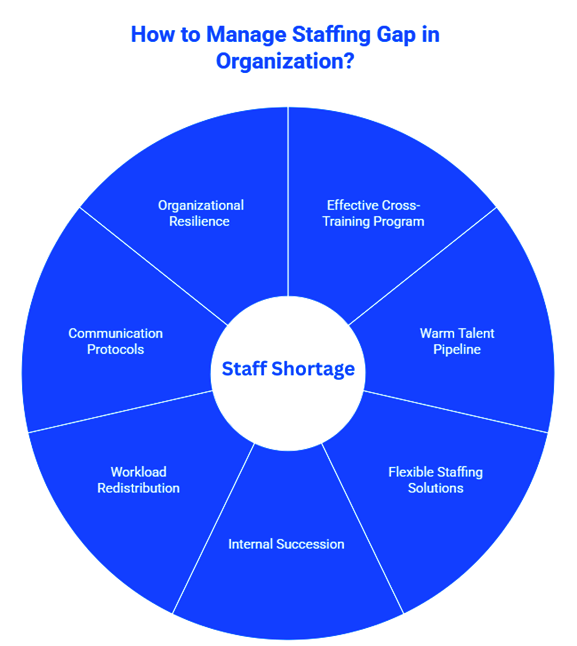 Tracey Taylor
Tracey Taylor
Nov 06, 2025
Reading Time: 7 Minutes

Workforce shortage can hit any time in any company, whether facing a resignation, an emergency absence, or an important team member headhunted by competitors. These situations create immediate pressure on teams and leadership alike. The real test of organizational resilience is not whether these gaps occurred; it is how effectively you respond when they do.
The cost of poor staffing extends far beyond the obvious. Productivity suffers; remaining team members face burnout from increased workloads, project timelines slip, and customer satisfaction can be compromised.
There is a competitive advantage to the organizations that have mastered the art of managing unexpected staffing gaps.

One of the most effective defenses against staffing disruptions is a comprehensive cross-training initiative. When employees have knowledge and understanding of multiple roles within an organization, sudden departures become far less catastrophic. Cross-training does not mean every employee needs to master every role that would be unrealistic, but strategic overlap in critical functions creates valuable flexibility.
Start by mapping out your organization's key positions and identifying which roles, if left vacant, would disrupt the most. Put your energy into training people for these critical roles first. Write down the key processes, let people shadow each other on the job, and switch up assignments every so often, so everyone gets hands-on experience. You will find this double duty-it saves you when someone leaves unexpectedly, and your team enjoys learning new things that help them grow professionally.

Here is the thing about scrambling to hire someone at the last minute. It drains your budget and eats up weeks you do not have.
Hiring someone at the last minute drains your budget and is time-consuming.
Innovative companies flip this script entirely. They are constantly building relationships with great candidates, even when there is no job to offer them. Think of it as keeping the coffee warm instead of brewing a fresh pot from scratch every time you need a cup.
Get out there, talk to talented people at conferences, connect with them on LinkedIn, and show up at industry meetups. Remember those impressive candidates you interviewed last year but could not extend an offer to? Stay in touch with them. And do not forget the good employees who left your company on favorable terms. Sometimes they realize the grass was not greener and would love to come back. They already know how things work at your place.
You could set up a monthly newsletter or a LinkedIn group for people interested in your company. That way, when you suddenly need someone, you are reaching out to folks who already know who you are and what you are about.

The job market looks different from what it did twenty years ago, and that's good news when you are in a bind. You have temporary workers, freelancers, contractors, and even experienced interim executives who can jump in quickly. These aren't permanent hires, which means you get someone competent handling the work while you take your time finding the perfect long-term fit.
Build relationships with a few solid staffing agencies before you are desperate. Get to know what they specialize in, how quickly they can deliver, and whether their candidates are actually good. Some organizations even negotiate agreements in advance so they can move quickly when things get urgent.
Remote work has changed the game, too. You are not limited to those who live within commuting distance anymore. Make sure you have your onboarding and communication down pat so temporary folks can actually contribute instead of wandering around confused for three weeks.
Succession planning should not be reserved solely for executive positions. Every critical role in your organization should have identified successors or at least a succession strategy. This planning helps you respond swiftly when unexpected departures occur.
Create individual development plans for high-potential employees that prepare them for advancement. Identify skill gaps and provide training, mentoring, and stretch assignments that build readiness. Document institutional knowledge before it walks out the door by encouraging knowledge-sharing sessions and maintaining updated process documentation.
Transparent succession planning also improves retention. When people can see where they are headed in your company, they are much less likely to jump on a ship. That alone can help you avoid some of these sudden departures.

So, someone just left, and work is piling up. What can be done now? Whatever you do, do not just dump everything on your remaining stuff. That is how you lose more people. You need to be smart about this and think beyond just getting through the following week.
Start by being ruthless about what needs to be done right now. Your departed colleague was handling some things that, honestly, can wait or don't even need to happen at all. Figure out what those are. Then split up what is left based on who has the capacity and the right skills, not just by dealing with tasks like cards until everyone has an equal pile.
Here is something interesting: these gaps sometimes show you where you have been doing things the hard way for no good reason. Maybe there is a process that could be automated, or a task that's been done "because that's how we've always done it." Use this as a chance to fix some of that stuff.

When someone leaves unexpectedly, your team needs to hear from you, and they need the straight story. They want to know what is happening, how it affects them, and what kind of support they are going to get while you figure things out.
Do not wait for people to start worrying and making up their own stories. Get ahead of it. Your team's already wondering if they are about to be buried in extra work, whether projects are going to fall apart, or if there is some bigger problem with the company. Talk to them honestly about your plan and your timeline.
Keep stakeholders in the top loop. Clients, partners, and other departments affected by the vacancy need appropriate communication about any impacts to service delivery or project timelines. Nobody likes surprises; everybody will respect you for being upfront about challenges.

Modern technology offers powerful tools for managing staffing disruptions. Project management platforms ensure work visibility and continuity regardless of personnel changes. Knowledge management systems preserve institutional wisdom. Collaboration tools enable seamless coordination across remaining team members and temporary staff. Build new human-less systems to reduce dependence.
When critical information lives in shared systems rather than personal files or memories, transitions become smoother, and automation can also handle routine tasks that might otherwise be dropped during staffing gaps.

When you put these strategies to work, like training people across different roles, staying connected with potential hires, bringing in temporary help when you need it, preparing people for bigger roles, dividing work sensibly, keeping everyone in the loop, and using the right tools, suddenly those staffing emergencies do not feel so catastrophic anymore.
Look, every company loses people unexpectedly. That is just reality. The companies that do well are not magical places where nobody ever quits. They are the ones who have figured out how to handle it without everything falling apart. Get started on this stuff now, before you are in crisis mode trying to figure it out on the fly.
The most common reasons are sudden resignations, medical leaves or employees being poached by competitors posing urgent challenges for teams and leadership
The staffing solution can be promptly addressed by hiring contractors, freelancers, and part-timers. They offer temporary coverage meanwhile company looks for long-term employees.
A sudden shortage of staff can increase workloads on the remaining team, resulting in fatigue, disengagement, and a significant drop in overall team productivity.
Cross-training employees in different overlapping roles builds flexibility. It allows teams to cover critical functions immediately during absences and minimize instant disruption.
Project management software, AI-driven recruitment platforms, and cloud-based systems help maintain productivity, redistribute workloads efficiently, and support strategic decision-making.
Enhance team efficiency and collaboration with StaffViz, the ultimate tool for managing remote and hybrid teams.
START FREE TRIAL
Powered by Staffviz